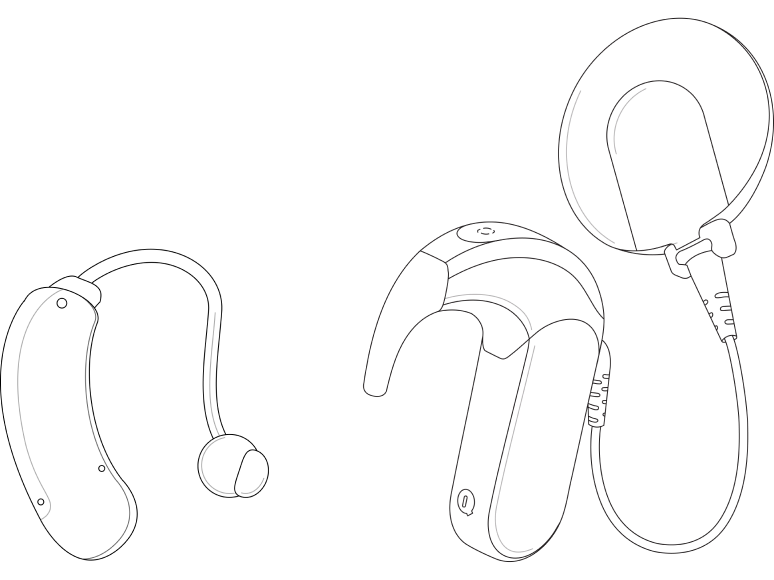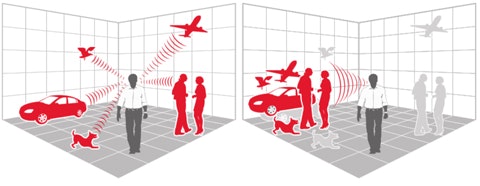Bimodal Hearing With a Cochlear Implant and a Hearing Aid
What’s the difference between a cochlear implant and a hearing aid? Can I use a hearing aid and a cochlear implant at the same time? What hearing aids are compatible with a cochlear implant?

Hearing Loss in Both Ears
Hearing loss is surprisingly common in children and adults. When hearing loss affects your inner ear, which is known as the cochlea, it’s referred to as sensorineural hearing loss.
If you only have hearing loss in one ear, this is known as unilateral hearing loss or single-sided deafness. If you have hearing loss in both ears, this is bilateral hearing loss.
You can be born with sensorineural hearing loss or it can be caused by infection, ototoxic medication, and other factors. If it becomes more serious over time, this is known as progressive hearing loss.
Often, progressive sensorineural hearing loss is asymmetrical, which means it affects one ear worse than the other ear.
If you have hearing loss in both ears and you are going to get a cochlear implant, find out about everything you want to know about how a cochlear implant and a hearing aid can work together to help you hear again with two ears.

Hearing Aids and Cochlear Implants
Hearing aids can be useful for moderate hearing loss, but they only make sounds louder from the outside, so they can’t effectively treat more serious inner ear hearing loss. If the sound-detecting hair cells in the cochlea aren’t working, they do not respond to the amplified acoustic sounds from a hearing aid.
If your hearing loss progresses, a cochlear implant can be a more effective treatment option. A cochlear implant works directly together with your inner ear to provide hearing. What is the difference between a cochlear implant and a hearing aid?
A cochlear implant uses tiny electrical pulses to bypass the non-working hair cells in your cochlea. In the cochlea, the implant signals are turned into nerve signals that travel the natural hearing pathways through your auditory nerve to your brain.
Even if the strongest hearing aids aren’t working for you, a cochlear implant can be a very effective option for helping to restore hearing.
Watch How MED-EL Cochlear Implants Work

Bimodal Hearing With a Cochlear Implant
Cochlear implants and hearing aids work differently, but they can also work together. When you wear a cochlear implant in one ear and a hearing aid in the other ear, this is called bimodal hearing.
Who can use bimodal hearing? If you have asymmetrical hearing loss, you may only need a cochlear implant in your worse ear. Or, your healthcare provider may only offer a cochlear implant for one ear, which is known as a unilateral cochlear implant.
Even if you qualify for cochlear implants for both ears, you might not have two cochlear implants right away. Adults often receive bilateral cochlear implants sequentially, which means the surgery for each ear is done separately over several months or more. In the time before the second cochlear implant surgery, you can keep using your hearing aid in your non-implanted ear.
Why would you want to use a cochlear implant in one ear and a hearing aid in the other ear? The answer is simple. Whenever possible, you should use both ears to hear.


Hear With Two Ears
What is the advantage of hearing with both ears? In natural hearing, you use two ears just like you use two eyes. Our brains compare and interpret these two separate sound signals to let us hear in 3D.
This is important because this lets our brains actively focus on what we want to hear while filtering out background noise. If you take away hearing from one ear, all those sounds become “shapeless.”
There are three main ways hearing with both ears provides better sound information to your brain.
Binaural summation
Hearing with both ears gives your brain a more complete and robust sound signal to combine, compare, and contrast. This makes it easier to hear in noise and helps reduce listening effort.
Squelch effect
When you can compare similar sounds between both ears, you brain uses this information to improve the quality of the sound and filter out background noise.
Head shadow effect
Your head is a natural sound barrier, so you want to be able to hear with both ears to avoid missing anything coming from one side.
When you can use both ears, it’s easier to hear in noisy environments like restaurants and family gatherings. With two hearing ears, you need less mental effort for listening. This is important because it can mean less exhaustion from everyday noise.
Using both ears also makes it easier to tell where sounds are coming from. Most importantly, hearing with both ears can have a significant positive improvement on your quality of life.
Benefits of hearing with both ears:
- Significantly better speech understanding in noise
- Much less listening effort
- Reduced social isolation
- Better sound localization
- Improved quality of life
"I really like the combination of the sound of the CI and the hearing aid! I can follow what the people sitting to my right say much better, I can localize and actually hear sounds with the CI that I can’t with the hearing aid."
Annette
Bimodal MED-EL CI user

Made for Bimodal Hearing
Now that we know why it’s important to hear with both ears, let’s look at bimodal listening again. If you’re going to get a cochlear implant in one ear and wear a hearing aid in the other ear, you have a lot to think about.
It’s important that you and your clinical team should decide what is best for you. We’ve put together this guide to help explain the difference between MED‑EL’s made-for-bimodal cochlear implants and other systems.
Do you need to use a specific brand of hearing aid with a cochlear implant? Is there a difference between cochlear implant companies?

Other Systems
Other cochlear implant systems are often promoted as having a specific partner-brand hearing aid. These systems are marketed as better because that hearing aid has been programmed to “treat sound the same” as that cochlear implant.
However, with these other systems, this usually really means significantly changing the way the hearing aid treats sound to be more like that cochlear implant. And in the end, this can mean that your hearing ability with the hearing aid is reduced. And when one ear can’t hear as well, then both ears aren’t hearing up to their full potential.

Bimodal With MED-EL
At MED-EL, our philosophy is to provide a closer match to natural hearing with our cochlear implants. The idea is simple: Provide a closer match between both ears, so that both ears can work better together.
This makes it easier to match any hearing aid—including the hearing aid you’re wearing right now. By letting both ears hear their best, both ears can work together better.

Closest to Natural Hearing
What do we mean by closest to natural hearing with our cochlear implants? There are two main qualities of natural hearing that we design our implants to follow as closely as possible: pitch and loudness.
Pitch is the frequency of a sound, like high-pitched bird chirps or low-pitched dog barks. Why is a closer to natural frequency match so important? Simply put, sounds should sound like a sound. Whether it’s the laughter of a loved one or your favorite music, we work to make sounds more like you remember.
In natural hearing, you use your whole cochlea to hear all the different pitches of sound. Our long, flexible electrode arrays are designed to use your whole cochlea. And we follow nature by using both types of natural sound coding to provide the closest match all the way from low pitches to high pitches.
The volume or loudness of sounds between both ears should also be balanced. We use a closer to natural loudness growth to help automatically balance the sound between our cochlear implants and any hearing aid.
With a closer match to natural hearing, you can use our MED-EL cochlear implants together with any hearing aid!
Learn more about how our cochlear implants are uniquely designed to provide the closest natural hearing.
Pitch Match
Most importantly for bimodal listening, with MED-EL the sounds from your cochlear implant and your hearing aid can be closely matched. Providing a full, matched range of frequencies across both ears is called “complete integration”. This can help make it easier for your brain to combine and compare the sounds from both ears.
Other cochlear implants are not designed to use your whole cochlea. For bimodal listening, these systems often use “partial integration”, which means the hearing aid is reprogrammed to only provide low frequencies in one ear and the cochlear implant is used to provide higher frequencies in the other ear. This leads to an unbalanced signal between your ears that offers less information to your brain.
Partial Integration
High
Frequency
Cochlear Implant

Hearing Aid
Low
Frequency
Complete Integration
High
Frequency
Cochlear Implant

Hearing Aid
Low
Frequency
Loudness Growth
When sounds get louder, the volume change should be balanced across both ears. This is especially important in noisy settings where loudness differences help you filter out background noise.
Our audio processors are designed to provide a close match to natural loudness growth. This makes it easier to match any hearing aid, but also provides a wide dynamic range for loudness growth. This means the person talking to you in a busy room can be heard over the background noise of the room.
Other systems may use a higher compression ratio (e.g. 12:1), which means the differences between louder sounds may be lost. It is also very different than a typical hearing aid compression ratio (2:1 or 3:1).
This means the volume changes between the ears will be unbalanced unless the hearing aid is reprogrammed to have high compression. And an unnaturally high compression ratio can affect speech understanding and sound quality with the hearing aid.

Hearing Your Best
So as you can see, if you match the pitch of sounds and the way they get louder and softer, both ears can work together. And why wouldn’t you want that match to be as close to natural hearing as possible? That’s why our cochlear implants are designed to provide this match to any hearing aid without compromise.
Stream Sound to Both Ears
You don’t have to compromise when it comes to streaming either. Our bimodal streaming system lets you stream sound from a compatible smartphone to both your hearing aid and your cochlear implant at the same time.

Benefits of Bimodal Hearing With MED-EL
There are all sorts of reasons why using a MED-EL cochlear implant and a hearing aid together makes sense, from sound quality to easy streaming options.
- Closer to natural match between ears
- Full range of sounds to both ears
- Better music enjoyment
- Significantly better hearing in quiet and noise
- Less listening effort
- More natural sound quality
- Improved sound localization
- Universal compatibility with any hearing aid
- Stream sound to both your ears
Ready to learn more about how a MED-EL cochlear implant can bring back the joy of sound to your life?
Download our candidate guide to learn all about our latest cochlear implant system.
The Next Steps
What are the next steps for getting a cochlear implant?
1
Assessment
First, your audiologist and clinical team will need to determine if a cochlear implant is an option for your hearing loss. If you’d like help finding a cochlear implant audiologist near you, please let us know with the contact form below.
2
Implantation
If a cochlear implant is the right solution, the next step is implantation. This is a safe and routine surgery that takes about an hour or two. Your doctor may have you stay at the hospital for a day or two. You should be back to your daily routine after a few days.
3
Activation
About four weeks after implantation, the implant can be activated. Your cochlear implant audiologist will program the implant for you and show you how to use everything. You can keep using your hearing aid together with your implant.
4
Rehabilitation
After activation, you will need to learn to understand sounds with your implanted ear. Daily listening exercises are very important to help maximize your benefit. These rehabilitation exercises can be done together with a hearing professional or at home.

Here With You
At MED-EL, we’ve been connecting families with life-changing hearing implants for more than 30 years so we understand that hearing loss can be difficult for you and your whole family. That’s why we’ve always been driven by one thing: A passion to help people with hearing loss.
It’s been that way since 1977, when our CEO, Dr. Ingeborg Hochmair, pioneered the modern cochlear implant along with her husband Erwin. Today we’ve grown to more than 2,900 employees covering 137 countries, but we’re still guided by the steadfast principles of our founders.
Our dedicated support network and local care specialists ensure our recipients are always well cared for. And when we create new technology, we make sure it’s compatible with earlier implants so that everyone can benefit. With MED-EL, our recipients know they can always count on us for a lifetime of better hearing.
When you’re ready to take the next step, we’ll be here with you every step of the way.


